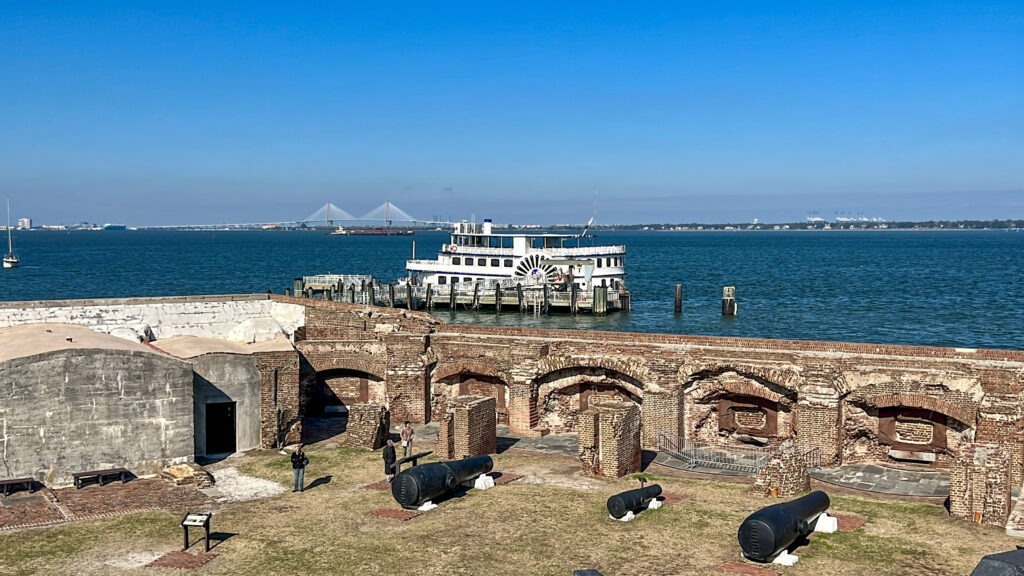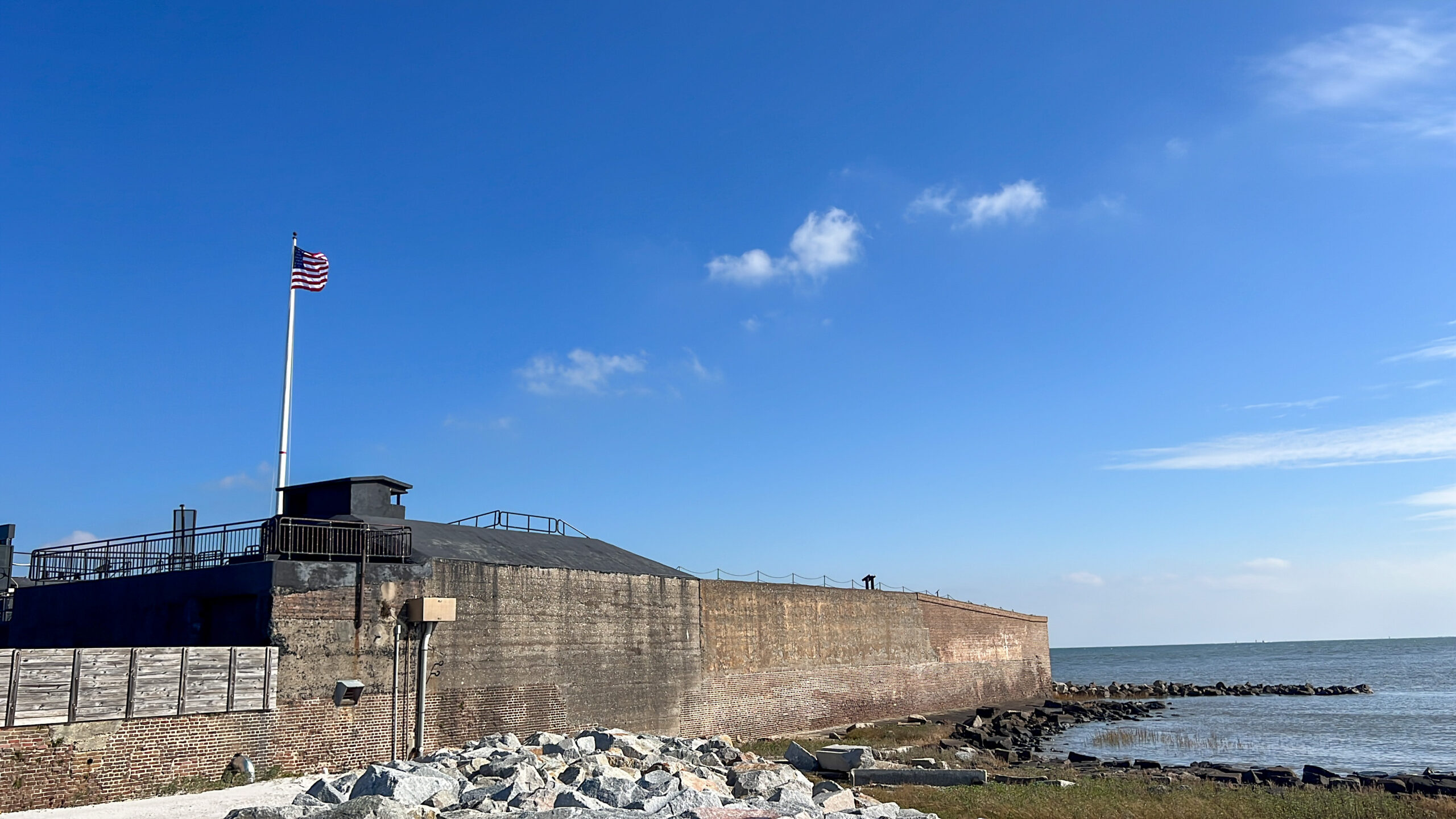It is well-accepted that the Civil War started at 4:30 am on April 12th, 1861. When Confederate forces led by General P.G.T. Beauregard fired on Union forces stationed at Fort Sumter. The small fort was built following the War of 1812 as part of the U.S. Third System. This system was a plan of nearly 50 forts to bolster America’s coastal defenses. This three-tiered, five-sided fort’s placement allowed it to control access to Charleston Harbor. A vital seaport to America and the South.
Disclosure: Some links on our site are affiliate links. If you purchase a linked item, we will make a commission, at no extra charge to you.
The fort sits atop a man-made island of thousands of tons of granite. Construction started in 1829 and continued on and off until 1860. When the island and the outer fortifications were complete. The fort’s interior and armaments were not yet completed. For this reason, the two companies of Federal troops guarding the harbor were stationed at nearby Fort Moultrie. A dilapidated garrison on the east side of the harbor on Sullivan’s Island.
The troops’ Commander, Major Robert Anderson, realized Fort Moultrie was vulnerable. With its guns directed out to sea, it cannot defend itself against attacks from land. Because of this, he elected to abandon it and move to the more easily defensible Fort Sumter on December 26, 1860. Shortly thereafter, South Carolina militias seized the city’s other forts. This left Fort Sumter as the sole Union outpost in Charleston.

A tense stalemate between the two opposing forces escalated on January 9, 1861, when cadets from the Citadel fired on the Star of the West. A Union supply ship bringing more than 200 troops and other supplies bound for Fort Sumter. While the ship was not sunk, it was driven back out to sea, unable to deliver its cargo. Over the next couple of months, Major Anderson refused repeated pleas to abandon the fort. By March 1861, over 3,000 militiamen besieged his position. Many other Federal military facilities in the South had already been seized. Many felt Fort Sumter was one of the few remaining hurdles to the Confederacy achieving sovereignty.
After his inauguration in March, President Lincoln announced his intention to relieve the fort with three unarmed ships. Lincoln’s plan was to send food to his besieged forces. The militia had already declared any attempt to resupply the fort would be seen as an act of aggression.
Jefferson Davis orders General Beauregard to take Fort Sumter on April 9. On April 11, General Beauregard asked one last time for the surrender of the fort. And again, Major Anderson refused.
Inside the fort with Anderson were 9 other officers, 68 enlisted men, 8 musicians, and 43 workers still completing construction. Shortly after 4:30 in the morning of April 12, General Beauregard gave the order to fire on Fort Sumter. Captain Abner Doubleday, later erroneously credited with the invention of baseball, ordered the first shots in defense a few hours later. The first shots of the Civil War have just been fired.
The 19 coastal batteries under Beauregards’ command unleashed a punishing barrage of cannon fire. An estimated 3,000 shots were fired at the fort in 34 hours. On Saturday, April 13, cannon fire had broken through the five-foot thick walls. Multiple fires broke out inside the fort. While the fort’s occupants only sustained minor injuries, they couldn’t hold out much longer.
The militia fire was becoming more precise as the bombardment continued. Around noon on April 13, the fort’s flagpole was hit. Without the ability to raise a surrender flag, General Beauregard’s forces had no way of telling if Major Anderson wished to surrender. Former US Senator from Texas Louis Wigfall took it upon himself to row out to the fort to seek surrender.
“Your flag is down, you are on fire,” Wigfall told Union troops, “and you are not firing your guns. General Beauregard wants to stop this.”
With his ammunition depleted, Major Anderson had no other choice but to surrender the fort a little after 2 pm. The War’s first engagement resulted in a Rebel victory.
Although no soldiers were killed during the shelling, two men died the following day. During an artillery salute before the Union evacuation, the premature detonation of a shell kills Pvt. Daniel Hough and another man.
Following the evacuation on the afternoon of April 14, 1861, the fort is occupied by Confederate forces. Company B of the First South Carolina Artillery Battalion and a volunteer company of the Palmetto Guard, a local militia unit. The fort will remain in Confederate hands for the next four years.
Commanders at Fort Sumter
Both Anderson and Beauregard attended West Point. Anderson served as Beauregard’s artillery instructor while he was a student. Later, Beauregard served as the Academy’s superintendent. Prior to the Civil War, both Northern and Southern officers trained at the United States Military Academy.
As secession split the country and a Civil War was imminent, the ties of former classmates began to fray. Many cadets from the southern states felt bound to leave for the Confederate States of America. Taking up commissions in its’ newly formed military. Cadets hailing from northern States rallied to defend the Union after the attack of Fort Sumter.

These West Point soldiers knew how to command troops in battle. With each respecting the other. Their communications before, during, and after the battle reflect the professionalism and courtesy they held for one another. Regardless, though, of any personal feelings felt for the other, they had their orders.
And at 3:30 in the morning of April 12, Major Anderson received this message;
SIR: By authority of Brigadier-General Beauregard, commanding the Provisional Forces of the Confederate States, we have the honor to notify you that he will open the fire of his batteries on Fort Sumter in one hour from this time.
His reply;
I have the honor to acknowledge the receipt of your communication demanding the evacuation of this fort, and to say, in reply thereto, that it is a demand with which I regret that my sense of honor, and of my obligations to my Government, prevent my compliance.
General Beauregard, trained as a Civil Engineer, served with distinction during the Mexican-American War. During his brief tenure as superintendent at West Point, he did little to hide his secessionist feelings. He quickly left to take up a commission in the newly formed Confederate Army. He commanded forces in the Western theater, earning victories in several battles. Including the First Battle of Bull Run. In April, 1865, he and his commander General Joseph E. Johnson, convinced Jefferson Davis and his cabinet that the war needed to end. The majority of the remaining Confederate armies surrendered to General Sherman.
Major Anderson graduated from West Point in 1825. During the Blackhawk War of 1832, he served as a Colonel of Illinois Volunteers. He has the distinction of mustering a young Abraham Lincoln into and out of military service. Although adamantly pro-Union, it was known that he took no issue with slavery. He did, however, feel that secession and war were not the answer. It was felt that an officer with southern roots and sympathetic to the southern cause could alleviate rising tensions.
On April 14, 1865, precisely 4 years after lowering it, Major Anderson raised the very same flag again over Fort Sumter. The war was over and the country reunited.
Tips for visiting Fort Sumter
- You will take a short ferry ride to the fort. While visiting the fort is free, the ferry ride has a cost associated with it. You can purchase tickets in the museum building.
- Snacks and refreshments are sold on the ferry ride.
- There is a small museum on the fort with air conditioning on hot days.
- Gift shops can be found in the Charleston museum and at the fort.
- Taking the first ferry ride of the day allows you to help raise the American flag over the fort.

